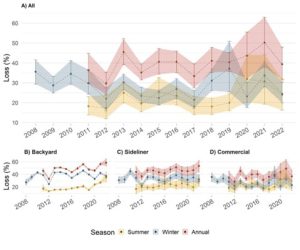UNITED STATES HONEY BEE COLONY LOSSES 2021-2022: PRELIMINARY RESULTS FROM THE BEE INFORMED PARTNERSHIP
JULY 27, 2022 BY THE BEE INFORMED TEAM

Note: This is a preliminary analysis. Sample sizes and estimates are likely to change. A more detailed final report is being prepared for publication in a peer-reviewed journal at a later date.
Dan Aurell1, Selina Bruckner1, Mikayla Wilson2, 3, Nathalie Steinhauer2, 3, *, Geoffrey Williams1, *
1Department of Entomology & Plant Pathology, Auburn University, Auburn, AL, USA
2Department of Entomology, University of Maryland, College Park, MD, USA
3Bee Informed Partnership, College Park, MD, USA
*Joint last authors
Corresponding Authors: nsteinha@umd.edu (NS) & williams@auburn.edu (GW)
The Bee Informed Partnership (https://beeinformed.org) is a non-profit organization that works alongside beekeepers to improve honey bee colony health and survivorship across the United States. One of the organization’s longest running programs, the national Colony Loss and Management Survey, was initiated with the support of the Apiary Inspectors of America in 2007. Since then it has monitored managed honey bee colony loss rates and identified risk factors and protective measures associated with beekeeping management (Steinhauer, vanEngelsdorp and Saegerman, 2021).
This year marks the 16th anniversary of the survey, which relies on voluntary participation of beekeepers across the country during the month of April. It covered the one year period between April 2021 and April 2022.
This year, 3,601 beekeepers that collectively managed 335,946 colonies on 1 October 2021 in the United States provided validated survey responses. This represented 12% of the estimated 2.70 million managed honey-producing colonies in the country in 2021 (USDA NASS, 2022).
Colony loss rates were calculated as the ratio of the number of colonies lost to the number of colonies managed over a defined period. Loss rates should not be interpreted as a change in population size because beekeepers can replace lost colonies throughout the year. Therefore, colony loss rates are best interpreted as a turn-over rate, as high levels of losses do not necessarily result in a decrease in the total number of colonies managed in the United States.
During Summer 2021 (1 April 2021 – 1 October 2021), an estimated 23.8% [16.3 – 31.9, 95% bootstrapped confidence interval] of managed colonies were lost in the United States (Fig. 1). This was lower – 7.3 pp − than last year’s estimated summer colony loss (31.1% [19.2 – 44.1 CI]), but it was 1.3 pp higher than the average summer loss reported by beekeepers since the summer of 2010 (22.5%, 11 year average), when summer losses were first monitored.
During Winter 2021-2022 (1 October 2021 – 1 April 2022), an estimated 24.2% [20.0 – 30.3 CI] of managed colonies in the United States were lost (Fig. 1). This represented an improvement of 9.3 percentage points (pp) over the previous winter loss rate (33.5% [28.0 – 40.7 CI]), and was 4.3 pp lower than the average winter loss (28.5%, 14 year average) reported by beekeepers since the start of the survey in 2008.
Over the entire year (1 April 2021 – 1 April 2022), beekeepers in the United States lost an estimated 39.0% [31.5 – 47.9 CI] of their managed honey bee colonies (Fig. 1). This was 11.8 pp lower than last year’s estimated annual loss (50.8% [30.8 – 63.1 CI]), which was the highest annual loss on record, and 0.7 pp lower than the average loss rate (39.7%, 11 year average) over the last 11 years.

Figure 1: Seasonal managed honey bee colony loss rates in the United States across years (A), and by types of operations (B-D). The loss rate was calculated as the total number of colonies lost divided by the number of colonies at risk during the season. Colonies at risk were composed of viable colonies, as well as new colonies made or acquired, while excluding colonies sold or parted with. Annual loss covers the whole period from one 1 April to the next 1 April (in red); Summer (1 April – 1 October, in yellow); Winter (1 October – 1 April, in blue). Error bars represent the 95% confidence interval obtained from a bootstrap resampling of the data (n-out-of-n, 1000 rep).
The honey bee industry in the United States is loosely divided into three groups of beekeepers − backyard (managing fewer than 50 colonies), sideliner (managing 51-500), and commercial (managing 501 or more colonies). As reported in previous years, backyard beekeepers experienced a higher annual rate of loss than commercial beekeepers in 2021-2022 (58.5% [53.4 – 64.4 CI] for backyard vs 36.6% [28.3 – 47 CI] for commercial). This represented the highest annual rate of loss on record for backyard beekeepers (10.6 pp more than their 11 year average of 47.9%), but it amounted to a typical year for commercial beekeepers (1.7 pp less than their 11 year average of 38.3%). Both backyard and sideliner beekeepers experienced winter rates of loss that were on par with previous years; however, commercial beekeepers experienced a lower winter rate of loss (22.8% [18.2 – 29.1]) compared to their historic average (14 year average of 27.2%).
Although the total number of honey bee colonies in the country has remained relatively stable over the last 20 years (~2.6 million colonies according to the USDA NASS Honey Reports), loss rates remain high, indicating that beekeepers are under substantial pressure to offset losses by creating new colonies every year. The Bee Informed Partnership’s annual Colony Loss and Management Survey offers an important record of such loss rates experienced by beekeepers across the United States each year. Before the start of the survey in 2007, no rigorous record was kept of the loss rates of colonies, making comparisons to historic levels difficult. In the last 16 years of the survey, our results have highlighted large variability in colony loss rates, not only among beekeeping operation types and locations, but also from year to year.
To obtain more information about the Bee Informed Partnership’s annual national Colony Loss and Management Survey, visit: https://beeinformed.org/citizen-science/loss-and-management-survey/.
We are here to share current happenings in the bee industry. Bee Culture gathers and shares articles published by outside sources. For more information about this specific article, please visit the original publish source: https://beeinformed.org/citizen-science/loss-and-management-survey/






